In 2007, Jennifer Solignac and David Elkington were shown images of a newly discovered set of books, of codices. They were surprising in one particular way: they were composed almost entirely of impure lead. Attempts to bring the lead codices into the public eye soon led to controversy and dismissals that they were fake – from people and institutions that had never even analyzed them.
However, patient analysis and investigation have revealed the fact that the lead codices are both authentic and ancient.
Visiting the Homeland of the Lead Codices
We had been shown a number of strange looking books or codices – a series of lead plates bound together by lead wire – seventy in all and had managed to take a lot of detailed, high definition images. Now we had to discover the valley where the codices came from. It was located in northern Jordan. During a number of visits there in 2009 and 2011 we discovered much: an intact first century burial chamber, an olive press and all the signs of very long-term habitation. There were caves everywhere, furthermore, it was known that the early Christians had been here – there was still an intact Christian monastic cell high up in the cliff-face.

Early Christian tomb at the valley site in northern Jordan. (© David Elkington)
“More Important than the Dead Sea Scrolls”
What we were looking at were very early books. The discovery was soon to be described as ‘more important than the Dead Sea Scrolls ’ by the Director of Antiquities in Amman, Jordan – and here we were in Northern Jordan, in pursuit of documents that could very well change everything we know of the origins of Christianity.
The documents first came to light in 2007 when we were first asked to provide an initial assessment. At first glance they looked unremarkable – odd leather books that looked quite beaten up and, frankly, such things are to be seen on the open market. Ever since the discovery of the Nag Hammadi texts in 1945 all manner of codices have flooded the market, most of them forgeries.
However, it was when we were informed that they were made entirely of lead rather than leather that we realized that we were looking at something unique. This was soon confirmed by an enquiry to the Palestine Exploration Fund in London: on the theme of lead codices we could find nothing.
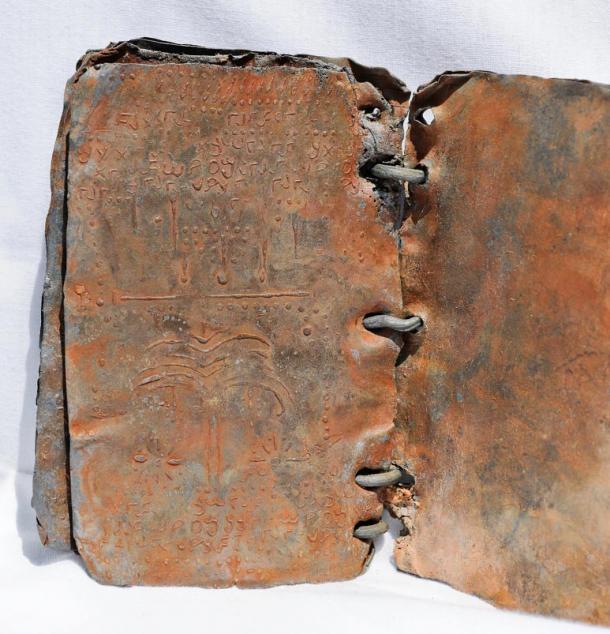
Symbols inside one of the lead codices. (© David Elkington)
The Codices Are Authentic
Initial analysis at several prominent laboratories confirmed the Roman provenance of the lead. The job was now to discover whether it was reused Roman lead – reused by cunning forgers on the hunt for willing but gullible buyers and considerable riches.
Ten years and fifteen separate tests later we knew these things were for real. But by this time, a campaign to suppress them had already begun. Dissonant voices had already said that the metal might be old but it had been re-beaten into these codices.
It was Prof. Roger Webb of the University of Surrey’s Ion Beam Centre, working with Matthew Hood, an independent analyst, who was able finally to entirely refute this supposition. Not only was the metal old, it also demonstrated all the signs of great antiquity. The codices are authentic.
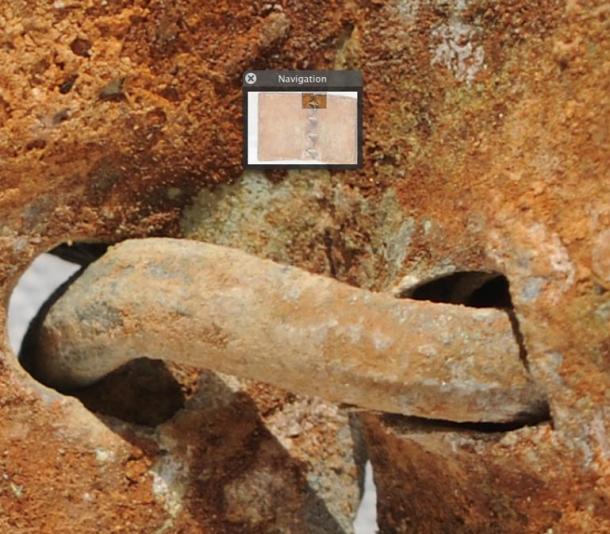
Corrosion around binding holes and on wire but wear indications on binding holes and wires suggest significant page turning has occurred. (© David Elkington)
Looking for Signs of Radiation and Corrosion
The first observation was a simple one: if there was no active radiation coming from the metal then it was not a product of the modern era. As Prof Webb has stated: ‘The lead naturally contains a radioactive isotope which decays away slowly after it has been mined. The lead can be re-activated from radioactive polonium in the air. This originates from naturally occurring Radon, which decays away to Polonium, the Polonium itself decaying ultimately to the radioactive Lead isotope we are looking for – this potentially gave rise to a difference we observed between the outer and inner pages of the codices, meaning that analysis of the objects must be performed carefully.’ (In 1945 the first of the Atom Bombs were exploded in the deserts of New Mexico. This event sent radioactive polonium into the sky – and, from that day on, any metal fabricated in forges across the globe, contains radioactive polonium.)
This test managed to confirm that the lead is older than 100 years: and one hundred years ago the information available to forgers was far less than it is now ergo, it is highly unlikely that they are forged. But this begs a question: if they are forgeries then what are they forgeries of? The metal of the codices is consistent with being Roman lead. Another critical factor is the state of the corrosion on the surface of the codices.
Modern lead is not only very pure but also very malleable to the touch; it is like plasticine when beaten out in sheets. The lead of the codices is highly impure but, significantly, it is fragile and in some cases is easily fractured. Quite simply, no one had ever seen or handled lead like it – a common observation of those who have come into contact with it. Under the microscope it exhibits all of the qualities of great age, with crystalline impurities leeching out of the metal, leaving holes in their wake – a process that takes upwards of 1800 years.
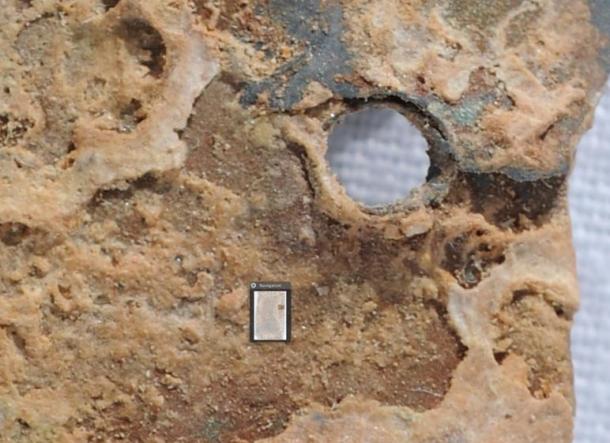
Significant accretion of mineral compounds within holes and cracks. (© David Elkington)
Depicting Sacred Symbols
The work of the metallurgists is done. We now had to find out what they were – and the answer was dramatic: for at the heart of the discovery was something astonishing, something of profound sanctity, whether you are a believer or not.
The collection of books that Jennifer and I had seen both in Jordan and in Israel were mostly small in size, not much larger than the average paperback. Some are even smaller, no bigger than the size of a human palm. All of them have illustrations of palm trees and menorahs on them as well as other symbols. The script upon them is mostly Paleo-Hebrew, a language that dates back a thousand years before Christ. Tellingly Aramaic is also to be seen – the lingua franca of Jesus’ time. Thus, we have a link between two separate periods.
Intriguingly, one of the most striking aspects of the illustrations on the codices is the presence of Temple-type architecture, in one codex the interior of the temple can be seen: in contemporary terms this would have been seen as a forbidden image, as would the representation of the seven-branch menorah. In its day this was seen as God’s own furniture – and came from the holiest place in the Temple – the Holy of Holies.
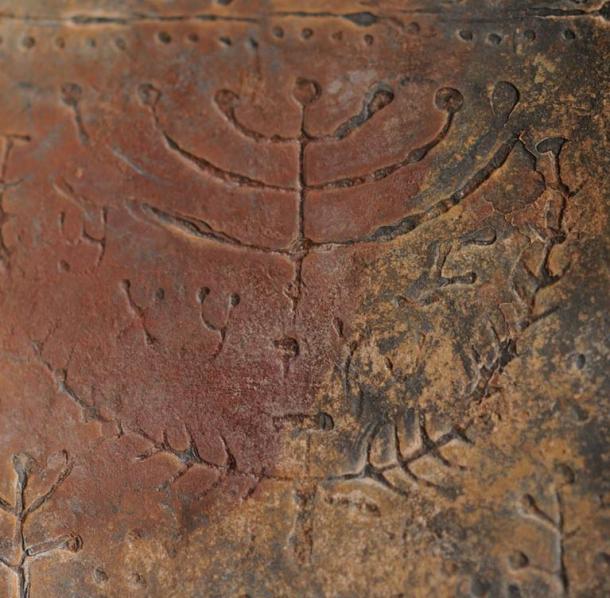
Depiction of the seven-branch menorah in one of the codices. (© David Elkington)
Was this the reason the codices were sealed and hidden away in caves? Because they were holy objects depicting secrets forbidden to anyone but initiates to see? The Second Book of Esdras (14:25-46) , an early Hebrew-Christian text , speaks of the making of ninety-four books – seventy of which are then hidden away in a cave.
However, more dramatic than this is the mention of a small book in Revelation 5 . (This is often – and mistakenly – translated as a scroll, but the original Greek says biblioridion – meaning book not scroll.) This book matches the description of the codex central to the discovery, a small book with seven seals down one side. On its front cover there is a portrait of a Nazarene-type figure. The description of this would appear to tally with that given in Revelation – which means only one thing: that it is an apocalypse, not the end of the world – but instead a book about a vision, about the secrets of the temple!
According to the eminent scholars thus far involved in assessing the language and iconography on the codices, the very fact that these texts exist in book form points to them being early Christian documents – the oldest thus far discovered. They have no problems with the authenticity – the codices merely confirm long held suspicions. The translations gained so far would seem to point to this.
But the script seems nothing more than a random set of quotations from Proverbs and Psalms, Daniel and other books of the Old Testament. What is it that they are trying to impart?
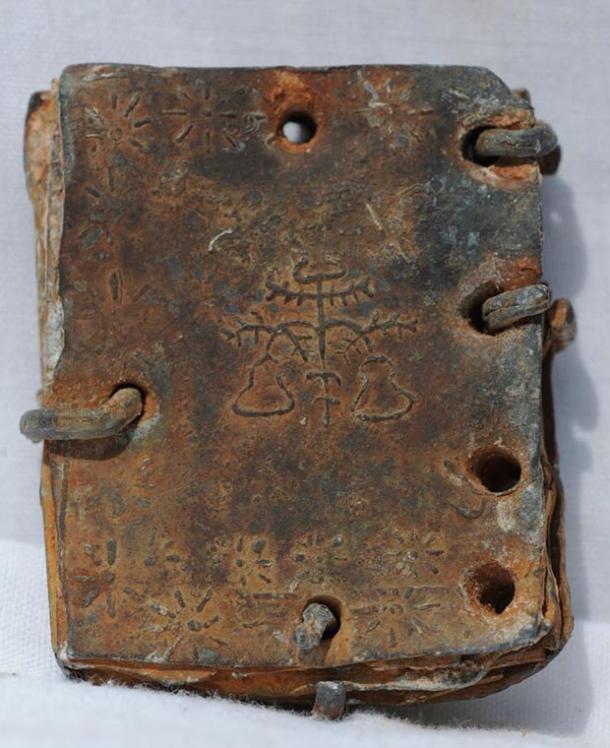
Symbols in one of the lead codices. (© David Elkington)
Testimonia
Well, the answer to that is that if we read the rest of the quotations these passages begin to reveal much. In essence, these books are testimonia. They bear witness to the truth as it was delivered from the mouth of the Messiah. These books are telling us of the coming of a messiah, of a great King who will liberate his people – and free them from oppression: but they speak of liberation from this world, of liberation from the burden of having to pay tax to Caesar. They speak of a great event that the messiah has come to oversee, and they speak of much else.
These books were predicted. In the 1950’s, Dr. Hugh Schonfield was translating the Damascus Document , one of the Dead Sea Scrolls, when he noticed that it spoke of a metal book, a very holy object that the scroll suggested, had a portrait of its Holy One on its cover. This is a good description of the codex central to the discovery.
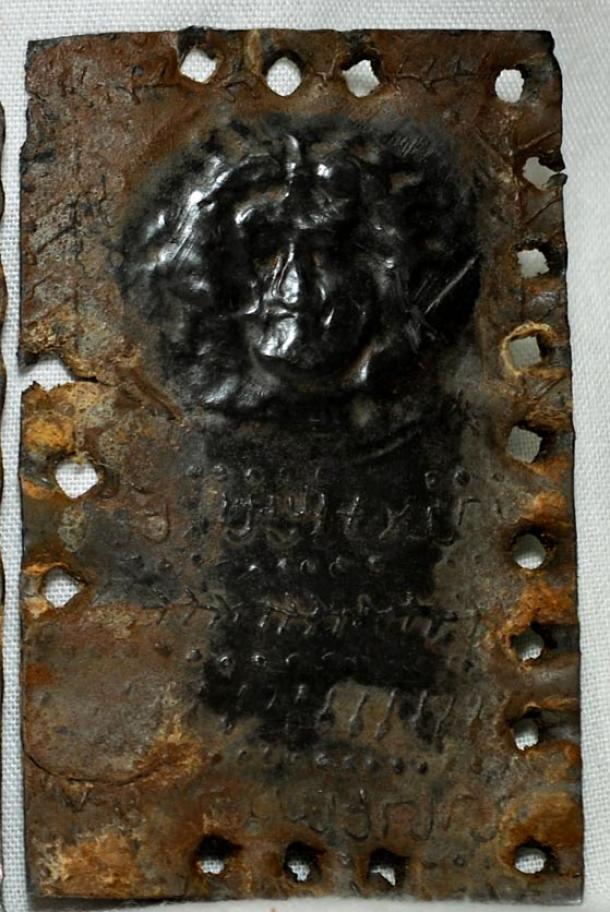
‘Face of God’ in the Lead codices. (© David Elkington)
Could this be the first icon? The icon from which all other icons are derived? Has Christ returned as he predicted in the New Testament?
Christianity has its secrets.
And if you have a secret, you have power over those who do not, perhaps that is why certain people and organizations are afraid of these sacred relics. It could also be the reason why a Medieval Pope Innocent III gave instruction for them to be tracked down – and destroyed.
Only time will tell.
There will be an announcement from the University of Surrey in the coming weeks on the latest ground-breaking data from analysis of the codices.
Top Image: An authentic codex, left, as opposed to a modern forgery, right, which is crude by comparison and betrays all of the hallmarks of modern manufacture: not the uneven patina, which is obviously applied and not accrued by age. Source: (© David Elkington)